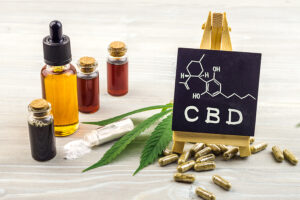
by Ryan Turner, a Laidlaw & Dr Gerald Swyer Scholar and a UCL Medical Student
Cannabis use disorder and CBD
Cannabis use disorder currently affects 22 million people worldwide,1 a number which is on the rise.2 Cannabis use disorder is primarily caused by the chemical tetrahydrocannabinol, or THC – the chemical in the plant that is associated with a “high”.
Cannabis use disorder is associated with a five-times increased risk of psychosis (a loss of contact of reality – for example where you see, hear or believe things that are not true).3 There are no medications currently recommended for treatment of cannabis use disorder.
It may be the case that another chemical in the cannabis plant – cannabidiol, or CBD as its commonly known – could be a cure for cannabis use disorder: the plant has the ability to be both the cause and cure. But what is CBD and why do people keep talking so much about it?

Medical CBD
CBD is considered to have a wide range of potential medicinal uses. The drug has been approved at high doses for treating rare forms of epilepsy.
Recently, low-dose hemp-derived CBD has been taking over the high street, with people using the drug for a variety of reasons such as pain and anxiety relief. However, CBD products sold over the counter lack quality assurance and typically contain very low doses of CBD (e.g. 25mg) that are unlikely to produce medical benefit.4 By contrast, clinical trials such as UCL’s medical research council (MRC)-funded trial tested higher doses of CBD (e.g. 200mg, 400mg and 800mg).
A randomised controlled trial of CBD for cannabis use disorder
Research conducted by UCL’s Clinical Psychopharmacology Unit, led by Dr Tom Freeman, (Addiction and Mental Health Group, University of Bath) may hold some of the answers. The researchers gave CBD or an inactive substance (placebo) to 82 volunteers who wanted to quit using cannabis and had failed to do so in the past. In the first clinical trial of its kind5, they showed that a daily dose of 400mg or 800mg of CBD helped people with cannabis use disorder to reduce their cannabis intake.
The study was carried out over two stages. At each stage, the volunteers were split into equal groups and given a dose of CBD or an inactive substance (placebo). They were asked to take two capsules of CBD or the inactive substance twice daily for 4 weeks. The study was designed to see which doses worked best when compared to the inactive substance.
Stage 1
In stage one, 48 people were randomly split into four groups of twelve. One group received the inactive substance. The three other groups received CBD at a dose of 200mg, 400mg or 800mg. In addition, all participants had six counselling sessions that were designed to help them quit using cannabis by increasing motivation.
Urine samples were taken each week to test for THC levels – this showed much cannabis had been consumed that week. Volunteers also reported the number of days they had not used cannabis that week. In this stage, the team found that 200mg of CBD did not work. They excluded 200mg from further investigations and recruited new volunteers for the next stage.
Stage 2
In stage two, 34 new volunteers were randomly split into three groups. Eleven received the inactive substance, 12 received 400mg of CBD and 11 received 800mg of CBD. The same methods were used to measure the amount of cannabis consumed as in stage one; the volunteers also received the same counselling.
The study found that CBD reduced the amount of cannabis used (as verified by the urine samples) and decreased the number of days per week that participants used cannabis. Importantly, there was no difference in side-effects between CBD and the inactive substance. The study showed that prescribed CBD doses between 400mg and 800mg could reduce problematic cannabis use.
Further studies are needed to investigate exactly how effective CBD might be for helping people with problematic cannabis use. Research needs to investigate whether or not these findings extend to other treatment lengths and whether CBD reduces cannabis use directly or by other means. Nonetheless, this study highlights that when administered at the correct dose, CBD can be safe and of benefit to those with cannabis use disorder.
References
- Degenhardt, L et al., 2018. The global burden of disease attributable to alcohol and drug use in 195 countries and territories, 1990–2016: a systematic analysis for the Global Burden of Disease Study 2016. The Lancet Psychiatry, [online] 5(12), pp.987-1012. Available at: <https://www.thelancet.com/journals/lanpsy/article/PIIS2215-0366(18)30337-7/fulltext> [Accessed 5 August 2020].
- Copeland, J. and Swift, W., 2009. Cannabis use disorder: Epidemiology and management. International Review of Psychiatry, [online] 21(2), pp.96-103. Available at: <https://www.tandfonline.com/doi/full/10.1080/09540260902782745?casa_token=UstGfmDzi9QAAAAA%3AM0kc9ic9ly6Rx3H8QN–0logdxcS2M3fkQn8qXiQ2Fli_0CmwUmLxaYcER3Qy9fsfW_-F1IiUY_i> [Accessed 5 August 2020].
- Di Forti, M et al., 2019. The contribution of cannabis use to variation in the incidence of psychotic disorder across Europe (EU-GEI): a multicentre case-control study. The Lancet Psychiatry, [online] 6(5), pp.427-436. Available at: <https://www.thelancet.com/journals/lanpsy/article/PIIS2215-0366(19)30048-3/fulltext> [Accessed 6 August 2020]
- Freeman, T. P., Hindocha, C., Green, S. F., & Bloomfield, M. A. (2019). Medicinal use of cannabis based products and cannabinoids. Bmj, 365.
- Freeman, T., Hindocha, C., Baio, G., Shaban, N., Thomas, E., Astbury, D., Freeman, A., Lees, R., Craft, S., Morrison, P., Bloomfield, M., O’Ryan, D., Kinghorn, J., Morgan, C., Mofeez, A. and Curran, H., 2020. Cannabidiol for the treatment of cannabis use disorder: a phase 2a, double-blind, placebo-controlled, randomised, adaptive Bayesian trial. The Lancet Psychiatry, [online] Available at: <https://www.thelancet.com/journals/lanpsy/article/PIIS2215-0366(20)30290-X/fulltext> [Accessed 14 August 2020].
The opinions expressed in this post reflect the views of the author(s) and do not necessarily represent the opinions or official positions of the SSA.
The SSA does not endorse nor guarantee the accuracy of the information in external sources or links and accepts no responsibility or liability for any consequences arising from the use of such information.

